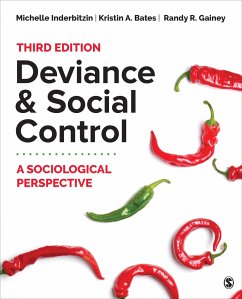Michelle L Inderbitzin, Kristin A Bates, Randy R Gainey
Deviance and Social Control
A Sociological Perspective
Michelle L Inderbitzin, Kristin A Bates, Randy R Gainey
Deviance and Social Control
A Sociological Perspective
- Broschiertes Buch
- Merkliste
- Auf die Merkliste
- Bewerten Bewerten
- Teilen
- Produkt teilen
- Produkterinnerung
- Produkterinnerung
Deviance and Social Control: A Sociological Perspective provides a sociological examination of deviant behavior in society, with a significant focus on the major sociological theories of deviance and society's reaction to deviance using readings from classic and current research.
Andere Kunden interessierten sich auch für
![The Invisible Woman The Invisible Woman]() Joanne E BelknapThe Invisible Woman199,99 €
Joanne E BelknapThe Invisible Woman199,99 €![Fundamentals of Research in Criminology and Criminal Justice Fundamentals of Research in Criminology and Criminal Justice]() Ronet D BachmanFundamentals of Research in Criminology and Criminal Justice236,99 €
Ronet D BachmanFundamentals of Research in Criminology and Criminal Justice236,99 €![Key Ideas in Criminology and Criminal Justice Key Ideas in Criminology and Criminal Justice]() Travis C PrattKey Ideas in Criminology and Criminal Justice120,99 €
Travis C PrattKey Ideas in Criminology and Criminal Justice120,99 €![Engaged Criminology Engaged Criminology]() Rena ZitoEngaged Criminology197,99 €
Rena ZitoEngaged Criminology197,99 €![Deviance and Social Control Deviance and Social Control]() Deviance and Social Control60,99 €
Deviance and Social Control60,99 €![Deviance and Social Control Deviance and Social Control]() Helen MarshallDeviance and Social Control77,99 €
Helen MarshallDeviance and Social Control77,99 €![Criminal (In)Justice Criminal (In)Justice]() Aaron FichtelbergCriminal (In)Justice91,99 €
Aaron FichtelbergCriminal (In)Justice91,99 €-
-
-
Deviance and Social Control: A Sociological Perspective provides a sociological examination of deviant behavior in society, with a significant focus on the major sociological theories of deviance and society's reaction to deviance using readings from classic and current research.
Hinweis: Dieser Artikel kann nur an eine deutsche Lieferadresse ausgeliefert werden.
Hinweis: Dieser Artikel kann nur an eine deutsche Lieferadresse ausgeliefert werden.
Produktdetails
- Produktdetails
- Verlag: Sage Publications
- 3rd edition
- Seitenzahl: 656
- Erscheinungstermin: 25. August 2020
- Englisch
- Abmessung: 231mm x 188mm x 23mm
- Gewicht: 998g
- ISBN-13: 9781544395777
- ISBN-10: 1544395779
- Artikelnr.: 59986437
- Herstellerkennzeichnung
- Produktsicherheitsverantwortliche/r
- Europaallee 1
- 36244 Bad Hersfeld
- gpsr@libri.de
- Verlag: Sage Publications
- 3rd edition
- Seitenzahl: 656
- Erscheinungstermin: 25. August 2020
- Englisch
- Abmessung: 231mm x 188mm x 23mm
- Gewicht: 998g
- ISBN-13: 9781544395777
- ISBN-10: 1544395779
- Artikelnr.: 59986437
- Herstellerkennzeichnung
- Produktsicherheitsverantwortliche/r
- Europaallee 1
- 36244 Bad Hersfeld
- gpsr@libri.de
Michelle Inderbitzin primarily studies prison culture, juvenile justice, and transformative education. She is co-editor of the book The Voluntary Sector in Prisons: Encouraging Personal and Institutional Change, and she won the American Society of Criminology Teaching Award in 2017. Dr. Inderbitzin earned her PhD in sociology from the University of Washington and has been a faculty member at Oregon State University since 2001. Along with her on-campus classes on crime and deviance, she regularly teaches classes and volunteers in Oregon's maximum-security prison for men and state youth correctional facilities.
Foreword
Preface
Acknowledgments
About the Authors
How to Read a Research Article
Chapter 1. Introduction to Deviance
Introduction
Conceptions of Deviance
The Sociological Imagination
The Importance of Theory and Its Relationship to Research
Global Perspectives on Deviance
Deviance and Disparity
Ideas in Action
Conclusion: Organization of the Book
Exercises and Discussion Questions
Key Terms
Chapter 2. The Diversity of Deviance
Introduction
Deviance and Its Varied Forms
Physical Deviance and Appearance: Ideals of Beauty, Self-Harm, and Body
Modification
Relationships and Deviance
Deviance in Cyberspace: Making Up the Norms as We Go
Subcultural Deviance
Elite Deviance, Corporate Deviance, and Workplace Misconduct
Positive Deviance
Global Perspectives on Types of Deviance
Deviance and Disparity: Differential Treatment in Dealing With Addiction,
Prostitution, and Graffiti
Ideas in Action: Guerrilla Gardening in Low-Income Areas
Question: So Who Are the Deviants? Answer: It Depends on Whom You Ask
Conclusion
Exercises and Discussion Questions
Key Terms
Chapter 3. Researching Deviance
Introduction
Methodological Approaches to Studying Deviance
Content Analysis
Secondary Data Sources
Ethical Considerations in Studying Deviance
Global Perspectives on Trials and Tribulations Involved in Researching
Deviance Across the Globe
Deviance and Disparity: Regulation of Smoking
Ideas in Action: Evaluating Programs and Policy
Conclusion
Endnote
Exercises and Discussion Questions
Key Terms
Chapter 4. Anomie/Strain Theory
Introduction
Development of Anomie/Strain Theory
Robert Merton and Adaptations to Anomie/Strain
Richard Cloward and Lloyd Ohlin, Differential Opportunity
Albert Cohen, Delinquent Boys
Robert Agnew, General Strain Theory
Messner and Rosenfeld, Crime and the American Dream- Institutional Anomie
Theory
Application of Anomie and Strain Theories
Critiques of Anomie and Strain Theories
Global Perspectives on Anomie/Strain Theory
Deviance and Disparity: The Occupy Wall Street Movement
Ideas in Action: Transforming Innovation Into Conformity and Legitimate
Success
Conclusion
Exercises and Discussion Questions
Key Terms
Chapter 5. Social Disorganization Theory
Introduction
Development of Social Disorganization Theory
Shaw and McKay's Study of Juvenile Delinquency and Urban Areas
Early Critiques of Social Disorganization Theory
Rebirth of Social Disorganization Theory
Empirical Tests of Social Disorganization Theory
Collective Efficacy as a Key Theoretical and Empirical Element of Social
Disorganization Theory
Global Perspectives on Social Disorganization Theory
Tests of Social Disorganization in Cities Outside the United States
More Theoretical and Empirical Advances and Divergences
Deviance and Disparity: Social Disorganization Theory
External Forces in the Creation of Social Disorganization
Ideas in Action: Programs and Policy From Social Disorganization and Broken
Windows Perspectives
Conclusion
Exercises and Discussion Questions
Key Terms
Chapter 6. Differential Association and Social Learning Theories
Introduction
Development of Differential Association Theory
Development of Akers's Social Learning Theory
Social Structure and Social Learning
Empirical Tests of Akers's Social Structure Social Learning Theory
Application of Differential Association and Social Learning
Critiques of Differential Association and Social Learning Theories
Cultural Deviance Theory and Subcultural Explanations of Deviance
Deviance and Disparity: Can Differential Association/Social Learning
Theories Explain Gender Disparities in Deviance?
Ideas in Action: Programs and Policy From a Social Learning Perspective
Global Perspectives on Testing Differential Association and Social Learning
Theories Outside of the United States
Conclusion
Exercises and Discussion Questions
Key Terms
Chapter 7. Social Control Theories of Deviance
Introduction
Development of Social Control Theory
Contemporary Additions to Social Control Theory
Application of Social Control Theories
Critiques of Social Control Theories
Global Perspectives on Deviance and Social Control Theories
Deviance and Disparity: The Cases of Teenage Homelessness
Ideas in Action: Homeboy Industries
Conclusion
Exercises and Discussion Questions
Key Terms
Chapter 8. Labeling Theory
Introduction
Development of Labeling Theory
How the Labeling Process Works
Labeling and Mental Illness
Labeling and Delinquency
Application of Labeling Theory
Impact of Labeling Theory
Critiques of Labeling Theory
Global Perspectives on Labeling Theory
Deviance and Disparity: When Is Drinking-or Not Drinking-Deviant on College
Campuses?
Ideas in Action: The "I Have a Dream" Foundation-Instilling Positive Labels
Conclusion
Exercises and Discussion Questions
Key Terms
Chapter 9. Marxist and Conflict Theories of Deviance
Introduction
Development of Marxist Theory
Development of Conflict Theory
Applications of Marxist and Conflict Theories
Critiques of Marxist and Conflict Theories
Global Perspectives on Deviance and Marxist/Conflict Theories
Deviance and Disparity: Voting Rights, Voter Suppression, Gerrymandering,
and Social Media
Voter Suppression and Conflict Theory
Ideas in Action: Voter Registration Drives
Conclusion
Exercises and Discussion Questions
Key Terms
Chapter 10. Critical Theories of Deviance
Introduction
Development of Feminist Criminology
Development of Critical Race Theory
Development of Peacemaking
Critiques of Critical Theories
Global Perspectives on Deviance and Critical Theories
Deviance and Disparity: Human Trafficking-Crossing Boundaries and Borders
Ideas in Action: What Can Be Done About Human Trafficking?
Conclusion
Exercises and Discussion Questions
Key Terms
Chapter 11. Societal Responses to Deviance
Introduction
Medicalization of Deviant Behavior
Policing, Supervision, and the Impact of Incarceration on Disadvantaged
Populations and Communities
Total Institutions
Correctional Facilities and the Purposes of Punishment
Gresham Sykes and the Pains of Imprisonment
Juvenile Correctional Facilities
Reentry: Challenges in Returning to the Community After Time in an
Institution
Public Fear and Social Control: The Case of Sex Offenders
Collateral Consequences: Effects on Communities and Families
Global Perspectives on the Social Control of Deviance
Deviance and Disparity: How Money Can Matter in Local Jails
Ideas in Action: College Programs in Prisons
Conclusion
Exercises and Discussion Questions
Key Terms
Chapter 12. Deviant Careers and Career Deviance
Introduction
Development of a Deviant Career and Career Deviance Approach
Getting Into Deviance: Onset of a Deviant Career
Risk and Protective Factors for Onset
Escalation, Persistence, and Specialization in Deviance
Sex Offenders: Generalists or Specialists?
The Case of Drinking and Driving
Specialization and General Deviance Is Not Always a Choice
Summary of Career Deviance: Specialists or Generalists?
Getting Out of the Game: Desistance From Career Deviance
Deviance and Disparity: Alcohol Use and Misuse Disparities Among
Heterosexual and Sexual Minority Youth
Global Perspectives on Cross-Cultural Interest in Deviant Careers and
Career Deviance
Ideas in Action: Programs and Policy From a Career Deviance and Deviant
Career Perspective
Conclusion
Exercises and Discussion Questions
Key Terms
Glossary
References and Additional Reading
Index
Preface
Acknowledgments
About the Authors
How to Read a Research Article
Chapter 1. Introduction to Deviance
Introduction
Conceptions of Deviance
The Sociological Imagination
The Importance of Theory and Its Relationship to Research
Global Perspectives on Deviance
Deviance and Disparity
Ideas in Action
Conclusion: Organization of the Book
Exercises and Discussion Questions
Key Terms
Chapter 2. The Diversity of Deviance
Introduction
Deviance and Its Varied Forms
Physical Deviance and Appearance: Ideals of Beauty, Self-Harm, and Body
Modification
Relationships and Deviance
Deviance in Cyberspace: Making Up the Norms as We Go
Subcultural Deviance
Elite Deviance, Corporate Deviance, and Workplace Misconduct
Positive Deviance
Global Perspectives on Types of Deviance
Deviance and Disparity: Differential Treatment in Dealing With Addiction,
Prostitution, and Graffiti
Ideas in Action: Guerrilla Gardening in Low-Income Areas
Question: So Who Are the Deviants? Answer: It Depends on Whom You Ask
Conclusion
Exercises and Discussion Questions
Key Terms
Chapter 3. Researching Deviance
Introduction
Methodological Approaches to Studying Deviance
Content Analysis
Secondary Data Sources
Ethical Considerations in Studying Deviance
Global Perspectives on Trials and Tribulations Involved in Researching
Deviance Across the Globe
Deviance and Disparity: Regulation of Smoking
Ideas in Action: Evaluating Programs and Policy
Conclusion
Endnote
Exercises and Discussion Questions
Key Terms
Chapter 4. Anomie/Strain Theory
Introduction
Development of Anomie/Strain Theory
Robert Merton and Adaptations to Anomie/Strain
Richard Cloward and Lloyd Ohlin, Differential Opportunity
Albert Cohen, Delinquent Boys
Robert Agnew, General Strain Theory
Messner and Rosenfeld, Crime and the American Dream- Institutional Anomie
Theory
Application of Anomie and Strain Theories
Critiques of Anomie and Strain Theories
Global Perspectives on Anomie/Strain Theory
Deviance and Disparity: The Occupy Wall Street Movement
Ideas in Action: Transforming Innovation Into Conformity and Legitimate
Success
Conclusion
Exercises and Discussion Questions
Key Terms
Chapter 5. Social Disorganization Theory
Introduction
Development of Social Disorganization Theory
Shaw and McKay's Study of Juvenile Delinquency and Urban Areas
Early Critiques of Social Disorganization Theory
Rebirth of Social Disorganization Theory
Empirical Tests of Social Disorganization Theory
Collective Efficacy as a Key Theoretical and Empirical Element of Social
Disorganization Theory
Global Perspectives on Social Disorganization Theory
Tests of Social Disorganization in Cities Outside the United States
More Theoretical and Empirical Advances and Divergences
Deviance and Disparity: Social Disorganization Theory
External Forces in the Creation of Social Disorganization
Ideas in Action: Programs and Policy From Social Disorganization and Broken
Windows Perspectives
Conclusion
Exercises and Discussion Questions
Key Terms
Chapter 6. Differential Association and Social Learning Theories
Introduction
Development of Differential Association Theory
Development of Akers's Social Learning Theory
Social Structure and Social Learning
Empirical Tests of Akers's Social Structure Social Learning Theory
Application of Differential Association and Social Learning
Critiques of Differential Association and Social Learning Theories
Cultural Deviance Theory and Subcultural Explanations of Deviance
Deviance and Disparity: Can Differential Association/Social Learning
Theories Explain Gender Disparities in Deviance?
Ideas in Action: Programs and Policy From a Social Learning Perspective
Global Perspectives on Testing Differential Association and Social Learning
Theories Outside of the United States
Conclusion
Exercises and Discussion Questions
Key Terms
Chapter 7. Social Control Theories of Deviance
Introduction
Development of Social Control Theory
Contemporary Additions to Social Control Theory
Application of Social Control Theories
Critiques of Social Control Theories
Global Perspectives on Deviance and Social Control Theories
Deviance and Disparity: The Cases of Teenage Homelessness
Ideas in Action: Homeboy Industries
Conclusion
Exercises and Discussion Questions
Key Terms
Chapter 8. Labeling Theory
Introduction
Development of Labeling Theory
How the Labeling Process Works
Labeling and Mental Illness
Labeling and Delinquency
Application of Labeling Theory
Impact of Labeling Theory
Critiques of Labeling Theory
Global Perspectives on Labeling Theory
Deviance and Disparity: When Is Drinking-or Not Drinking-Deviant on College
Campuses?
Ideas in Action: The "I Have a Dream" Foundation-Instilling Positive Labels
Conclusion
Exercises and Discussion Questions
Key Terms
Chapter 9. Marxist and Conflict Theories of Deviance
Introduction
Development of Marxist Theory
Development of Conflict Theory
Applications of Marxist and Conflict Theories
Critiques of Marxist and Conflict Theories
Global Perspectives on Deviance and Marxist/Conflict Theories
Deviance and Disparity: Voting Rights, Voter Suppression, Gerrymandering,
and Social Media
Voter Suppression and Conflict Theory
Ideas in Action: Voter Registration Drives
Conclusion
Exercises and Discussion Questions
Key Terms
Chapter 10. Critical Theories of Deviance
Introduction
Development of Feminist Criminology
Development of Critical Race Theory
Development of Peacemaking
Critiques of Critical Theories
Global Perspectives on Deviance and Critical Theories
Deviance and Disparity: Human Trafficking-Crossing Boundaries and Borders
Ideas in Action: What Can Be Done About Human Trafficking?
Conclusion
Exercises and Discussion Questions
Key Terms
Chapter 11. Societal Responses to Deviance
Introduction
Medicalization of Deviant Behavior
Policing, Supervision, and the Impact of Incarceration on Disadvantaged
Populations and Communities
Total Institutions
Correctional Facilities and the Purposes of Punishment
Gresham Sykes and the Pains of Imprisonment
Juvenile Correctional Facilities
Reentry: Challenges in Returning to the Community After Time in an
Institution
Public Fear and Social Control: The Case of Sex Offenders
Collateral Consequences: Effects on Communities and Families
Global Perspectives on the Social Control of Deviance
Deviance and Disparity: How Money Can Matter in Local Jails
Ideas in Action: College Programs in Prisons
Conclusion
Exercises and Discussion Questions
Key Terms
Chapter 12. Deviant Careers and Career Deviance
Introduction
Development of a Deviant Career and Career Deviance Approach
Getting Into Deviance: Onset of a Deviant Career
Risk and Protective Factors for Onset
Escalation, Persistence, and Specialization in Deviance
Sex Offenders: Generalists or Specialists?
The Case of Drinking and Driving
Specialization and General Deviance Is Not Always a Choice
Summary of Career Deviance: Specialists or Generalists?
Getting Out of the Game: Desistance From Career Deviance
Deviance and Disparity: Alcohol Use and Misuse Disparities Among
Heterosexual and Sexual Minority Youth
Global Perspectives on Cross-Cultural Interest in Deviant Careers and
Career Deviance
Ideas in Action: Programs and Policy From a Career Deviance and Deviant
Career Perspective
Conclusion
Exercises and Discussion Questions
Key Terms
Glossary
References and Additional Reading
Index
Foreword
Preface
Acknowledgments
About the Authors
How to Read a Research Article
Chapter 1. Introduction to Deviance
Introduction
Conceptions of Deviance
The Sociological Imagination
The Importance of Theory and Its Relationship to Research
Global Perspectives on Deviance
Deviance and Disparity
Ideas in Action
Conclusion: Organization of the Book
Exercises and Discussion Questions
Key Terms
Chapter 2. The Diversity of Deviance
Introduction
Deviance and Its Varied Forms
Physical Deviance and Appearance: Ideals of Beauty, Self-Harm, and Body
Modification
Relationships and Deviance
Deviance in Cyberspace: Making Up the Norms as We Go
Subcultural Deviance
Elite Deviance, Corporate Deviance, and Workplace Misconduct
Positive Deviance
Global Perspectives on Types of Deviance
Deviance and Disparity: Differential Treatment in Dealing With Addiction,
Prostitution, and Graffiti
Ideas in Action: Guerrilla Gardening in Low-Income Areas
Question: So Who Are the Deviants? Answer: It Depends on Whom You Ask
Conclusion
Exercises and Discussion Questions
Key Terms
Chapter 3. Researching Deviance
Introduction
Methodological Approaches to Studying Deviance
Content Analysis
Secondary Data Sources
Ethical Considerations in Studying Deviance
Global Perspectives on Trials and Tribulations Involved in Researching
Deviance Across the Globe
Deviance and Disparity: Regulation of Smoking
Ideas in Action: Evaluating Programs and Policy
Conclusion
Endnote
Exercises and Discussion Questions
Key Terms
Chapter 4. Anomie/Strain Theory
Introduction
Development of Anomie/Strain Theory
Robert Merton and Adaptations to Anomie/Strain
Richard Cloward and Lloyd Ohlin, Differential Opportunity
Albert Cohen, Delinquent Boys
Robert Agnew, General Strain Theory
Messner and Rosenfeld, Crime and the American Dream- Institutional Anomie
Theory
Application of Anomie and Strain Theories
Critiques of Anomie and Strain Theories
Global Perspectives on Anomie/Strain Theory
Deviance and Disparity: The Occupy Wall Street Movement
Ideas in Action: Transforming Innovation Into Conformity and Legitimate
Success
Conclusion
Exercises and Discussion Questions
Key Terms
Chapter 5. Social Disorganization Theory
Introduction
Development of Social Disorganization Theory
Shaw and McKay's Study of Juvenile Delinquency and Urban Areas
Early Critiques of Social Disorganization Theory
Rebirth of Social Disorganization Theory
Empirical Tests of Social Disorganization Theory
Collective Efficacy as a Key Theoretical and Empirical Element of Social
Disorganization Theory
Global Perspectives on Social Disorganization Theory
Tests of Social Disorganization in Cities Outside the United States
More Theoretical and Empirical Advances and Divergences
Deviance and Disparity: Social Disorganization Theory
External Forces in the Creation of Social Disorganization
Ideas in Action: Programs and Policy From Social Disorganization and Broken
Windows Perspectives
Conclusion
Exercises and Discussion Questions
Key Terms
Chapter 6. Differential Association and Social Learning Theories
Introduction
Development of Differential Association Theory
Development of Akers's Social Learning Theory
Social Structure and Social Learning
Empirical Tests of Akers's Social Structure Social Learning Theory
Application of Differential Association and Social Learning
Critiques of Differential Association and Social Learning Theories
Cultural Deviance Theory and Subcultural Explanations of Deviance
Deviance and Disparity: Can Differential Association/Social Learning
Theories Explain Gender Disparities in Deviance?
Ideas in Action: Programs and Policy From a Social Learning Perspective
Global Perspectives on Testing Differential Association and Social Learning
Theories Outside of the United States
Conclusion
Exercises and Discussion Questions
Key Terms
Chapter 7. Social Control Theories of Deviance
Introduction
Development of Social Control Theory
Contemporary Additions to Social Control Theory
Application of Social Control Theories
Critiques of Social Control Theories
Global Perspectives on Deviance and Social Control Theories
Deviance and Disparity: The Cases of Teenage Homelessness
Ideas in Action: Homeboy Industries
Conclusion
Exercises and Discussion Questions
Key Terms
Chapter 8. Labeling Theory
Introduction
Development of Labeling Theory
How the Labeling Process Works
Labeling and Mental Illness
Labeling and Delinquency
Application of Labeling Theory
Impact of Labeling Theory
Critiques of Labeling Theory
Global Perspectives on Labeling Theory
Deviance and Disparity: When Is Drinking-or Not Drinking-Deviant on College
Campuses?
Ideas in Action: The "I Have a Dream" Foundation-Instilling Positive Labels
Conclusion
Exercises and Discussion Questions
Key Terms
Chapter 9. Marxist and Conflict Theories of Deviance
Introduction
Development of Marxist Theory
Development of Conflict Theory
Applications of Marxist and Conflict Theories
Critiques of Marxist and Conflict Theories
Global Perspectives on Deviance and Marxist/Conflict Theories
Deviance and Disparity: Voting Rights, Voter Suppression, Gerrymandering,
and Social Media
Voter Suppression and Conflict Theory
Ideas in Action: Voter Registration Drives
Conclusion
Exercises and Discussion Questions
Key Terms
Chapter 10. Critical Theories of Deviance
Introduction
Development of Feminist Criminology
Development of Critical Race Theory
Development of Peacemaking
Critiques of Critical Theories
Global Perspectives on Deviance and Critical Theories
Deviance and Disparity: Human Trafficking-Crossing Boundaries and Borders
Ideas in Action: What Can Be Done About Human Trafficking?
Conclusion
Exercises and Discussion Questions
Key Terms
Chapter 11. Societal Responses to Deviance
Introduction
Medicalization of Deviant Behavior
Policing, Supervision, and the Impact of Incarceration on Disadvantaged
Populations and Communities
Total Institutions
Correctional Facilities and the Purposes of Punishment
Gresham Sykes and the Pains of Imprisonment
Juvenile Correctional Facilities
Reentry: Challenges in Returning to the Community After Time in an
Institution
Public Fear and Social Control: The Case of Sex Offenders
Collateral Consequences: Effects on Communities and Families
Global Perspectives on the Social Control of Deviance
Deviance and Disparity: How Money Can Matter in Local Jails
Ideas in Action: College Programs in Prisons
Conclusion
Exercises and Discussion Questions
Key Terms
Chapter 12. Deviant Careers and Career Deviance
Introduction
Development of a Deviant Career and Career Deviance Approach
Getting Into Deviance: Onset of a Deviant Career
Risk and Protective Factors for Onset
Escalation, Persistence, and Specialization in Deviance
Sex Offenders: Generalists or Specialists?
The Case of Drinking and Driving
Specialization and General Deviance Is Not Always a Choice
Summary of Career Deviance: Specialists or Generalists?
Getting Out of the Game: Desistance From Career Deviance
Deviance and Disparity: Alcohol Use and Misuse Disparities Among
Heterosexual and Sexual Minority Youth
Global Perspectives on Cross-Cultural Interest in Deviant Careers and
Career Deviance
Ideas in Action: Programs and Policy From a Career Deviance and Deviant
Career Perspective
Conclusion
Exercises and Discussion Questions
Key Terms
Glossary
References and Additional Reading
Index
Preface
Acknowledgments
About the Authors
How to Read a Research Article
Chapter 1. Introduction to Deviance
Introduction
Conceptions of Deviance
The Sociological Imagination
The Importance of Theory and Its Relationship to Research
Global Perspectives on Deviance
Deviance and Disparity
Ideas in Action
Conclusion: Organization of the Book
Exercises and Discussion Questions
Key Terms
Chapter 2. The Diversity of Deviance
Introduction
Deviance and Its Varied Forms
Physical Deviance and Appearance: Ideals of Beauty, Self-Harm, and Body
Modification
Relationships and Deviance
Deviance in Cyberspace: Making Up the Norms as We Go
Subcultural Deviance
Elite Deviance, Corporate Deviance, and Workplace Misconduct
Positive Deviance
Global Perspectives on Types of Deviance
Deviance and Disparity: Differential Treatment in Dealing With Addiction,
Prostitution, and Graffiti
Ideas in Action: Guerrilla Gardening in Low-Income Areas
Question: So Who Are the Deviants? Answer: It Depends on Whom You Ask
Conclusion
Exercises and Discussion Questions
Key Terms
Chapter 3. Researching Deviance
Introduction
Methodological Approaches to Studying Deviance
Content Analysis
Secondary Data Sources
Ethical Considerations in Studying Deviance
Global Perspectives on Trials and Tribulations Involved in Researching
Deviance Across the Globe
Deviance and Disparity: Regulation of Smoking
Ideas in Action: Evaluating Programs and Policy
Conclusion
Endnote
Exercises and Discussion Questions
Key Terms
Chapter 4. Anomie/Strain Theory
Introduction
Development of Anomie/Strain Theory
Robert Merton and Adaptations to Anomie/Strain
Richard Cloward and Lloyd Ohlin, Differential Opportunity
Albert Cohen, Delinquent Boys
Robert Agnew, General Strain Theory
Messner and Rosenfeld, Crime and the American Dream- Institutional Anomie
Theory
Application of Anomie and Strain Theories
Critiques of Anomie and Strain Theories
Global Perspectives on Anomie/Strain Theory
Deviance and Disparity: The Occupy Wall Street Movement
Ideas in Action: Transforming Innovation Into Conformity and Legitimate
Success
Conclusion
Exercises and Discussion Questions
Key Terms
Chapter 5. Social Disorganization Theory
Introduction
Development of Social Disorganization Theory
Shaw and McKay's Study of Juvenile Delinquency and Urban Areas
Early Critiques of Social Disorganization Theory
Rebirth of Social Disorganization Theory
Empirical Tests of Social Disorganization Theory
Collective Efficacy as a Key Theoretical and Empirical Element of Social
Disorganization Theory
Global Perspectives on Social Disorganization Theory
Tests of Social Disorganization in Cities Outside the United States
More Theoretical and Empirical Advances and Divergences
Deviance and Disparity: Social Disorganization Theory
External Forces in the Creation of Social Disorganization
Ideas in Action: Programs and Policy From Social Disorganization and Broken
Windows Perspectives
Conclusion
Exercises and Discussion Questions
Key Terms
Chapter 6. Differential Association and Social Learning Theories
Introduction
Development of Differential Association Theory
Development of Akers's Social Learning Theory
Social Structure and Social Learning
Empirical Tests of Akers's Social Structure Social Learning Theory
Application of Differential Association and Social Learning
Critiques of Differential Association and Social Learning Theories
Cultural Deviance Theory and Subcultural Explanations of Deviance
Deviance and Disparity: Can Differential Association/Social Learning
Theories Explain Gender Disparities in Deviance?
Ideas in Action: Programs and Policy From a Social Learning Perspective
Global Perspectives on Testing Differential Association and Social Learning
Theories Outside of the United States
Conclusion
Exercises and Discussion Questions
Key Terms
Chapter 7. Social Control Theories of Deviance
Introduction
Development of Social Control Theory
Contemporary Additions to Social Control Theory
Application of Social Control Theories
Critiques of Social Control Theories
Global Perspectives on Deviance and Social Control Theories
Deviance and Disparity: The Cases of Teenage Homelessness
Ideas in Action: Homeboy Industries
Conclusion
Exercises and Discussion Questions
Key Terms
Chapter 8. Labeling Theory
Introduction
Development of Labeling Theory
How the Labeling Process Works
Labeling and Mental Illness
Labeling and Delinquency
Application of Labeling Theory
Impact of Labeling Theory
Critiques of Labeling Theory
Global Perspectives on Labeling Theory
Deviance and Disparity: When Is Drinking-or Not Drinking-Deviant on College
Campuses?
Ideas in Action: The "I Have a Dream" Foundation-Instilling Positive Labels
Conclusion
Exercises and Discussion Questions
Key Terms
Chapter 9. Marxist and Conflict Theories of Deviance
Introduction
Development of Marxist Theory
Development of Conflict Theory
Applications of Marxist and Conflict Theories
Critiques of Marxist and Conflict Theories
Global Perspectives on Deviance and Marxist/Conflict Theories
Deviance and Disparity: Voting Rights, Voter Suppression, Gerrymandering,
and Social Media
Voter Suppression and Conflict Theory
Ideas in Action: Voter Registration Drives
Conclusion
Exercises and Discussion Questions
Key Terms
Chapter 10. Critical Theories of Deviance
Introduction
Development of Feminist Criminology
Development of Critical Race Theory
Development of Peacemaking
Critiques of Critical Theories
Global Perspectives on Deviance and Critical Theories
Deviance and Disparity: Human Trafficking-Crossing Boundaries and Borders
Ideas in Action: What Can Be Done About Human Trafficking?
Conclusion
Exercises and Discussion Questions
Key Terms
Chapter 11. Societal Responses to Deviance
Introduction
Medicalization of Deviant Behavior
Policing, Supervision, and the Impact of Incarceration on Disadvantaged
Populations and Communities
Total Institutions
Correctional Facilities and the Purposes of Punishment
Gresham Sykes and the Pains of Imprisonment
Juvenile Correctional Facilities
Reentry: Challenges in Returning to the Community After Time in an
Institution
Public Fear and Social Control: The Case of Sex Offenders
Collateral Consequences: Effects on Communities and Families
Global Perspectives on the Social Control of Deviance
Deviance and Disparity: How Money Can Matter in Local Jails
Ideas in Action: College Programs in Prisons
Conclusion
Exercises and Discussion Questions
Key Terms
Chapter 12. Deviant Careers and Career Deviance
Introduction
Development of a Deviant Career and Career Deviance Approach
Getting Into Deviance: Onset of a Deviant Career
Risk and Protective Factors for Onset
Escalation, Persistence, and Specialization in Deviance
Sex Offenders: Generalists or Specialists?
The Case of Drinking and Driving
Specialization and General Deviance Is Not Always a Choice
Summary of Career Deviance: Specialists or Generalists?
Getting Out of the Game: Desistance From Career Deviance
Deviance and Disparity: Alcohol Use and Misuse Disparities Among
Heterosexual and Sexual Minority Youth
Global Perspectives on Cross-Cultural Interest in Deviant Careers and
Career Deviance
Ideas in Action: Programs and Policy From a Career Deviance and Deviant
Career Perspective
Conclusion
Exercises and Discussion Questions
Key Terms
Glossary
References and Additional Reading
Index








